Best Time to Surf in Portugal – & Everything You Need to Know About Surfing in Portugal

When you think of surfing in Portugal, you probably think of the 100-foot monster waves of Nazare, but Portugal is a surfing mecca for all levels. Portugal has almost 1000km of coastline and countless surf breaks. There are waves for experienced surfers who want to challenge themselves and level up their skills and there are beaches perfect for a first-time beginner.
The best time to surf in Portugal depends on a couple of factors – your skill level, the time of year, and location – all of which will be covered in this post.
BEST TIME TO SURF IN PORTUGAL
Portugal is very consistent in terms of surf and no matter what time of year you go you will be able to find waves. The best time to surf in Portugal depends on your skill level, and from there you can choose a location and time of year. Here is a breakdown by skill level of the best time to find your perfect wave.
- Beginner // Late May – Early September // Summertime has the perfect conditions for beginners with smaller swells and calmer conditions. The weather is warmer and you can go for a lesson and enjoy a beach day after. There are more tourists during this time and popular beginner spots can be busy but don’t let this deter you from trying out the sport.
- Intermediate // September – November & April // For intermediate surfers, shoulder season is the perfect time to surf in Portugal. The crowds clear out and the water is a bit warmer in early winter.
- Advanced // November – February // If you want to surf big waves (or just watch the action) winter is
the time to visit Portugal. Pro surfers from all over the world come to surf in winter in Portugal.
Ok, now let’s break it down by the best locations by season:
- Summer (June – August) // In the summer months the Algarve has consistently good waves. The central west coast (Ericeira, Peniche, Sintra) is also good during the summer. Be aware that during the summer there are more crowds and more beginners in the water.
- Fall (September – November) // When the waves start to get bigger and the crowds get smaller the central west coast is the place to go. This is a perfect time and location for intermediate surfers. As you start to get later into November conditions can start to get bigger and messier so make sure to check the surf forecast.
- Winter (December – February) // If you are a beginner, the best option during winter is the Algarve or Cascais where there is more protection from the larger swells. If you are an intermediate or advanced surfer you can chase the epic swells in the North.
- Spring (March – May) // Early spring is the best time to surf Northern Portugal if you want to avoid crowds. Late spring has good conditions for beginners on all coasts but will be more crowded during this time.
BEST PLACES TO SURF IN PORTUGAL
With almost 1000 km of coastline, it is impossible to cover all of the surf breaks in Portugal. I decided to focus on locations that have multiple beaches and waves for different skill levels. Each of these locations has a variety of options and you can pick and choose where to visit based on your skill level – and also get a taste of the best coastal towns in Portugal!
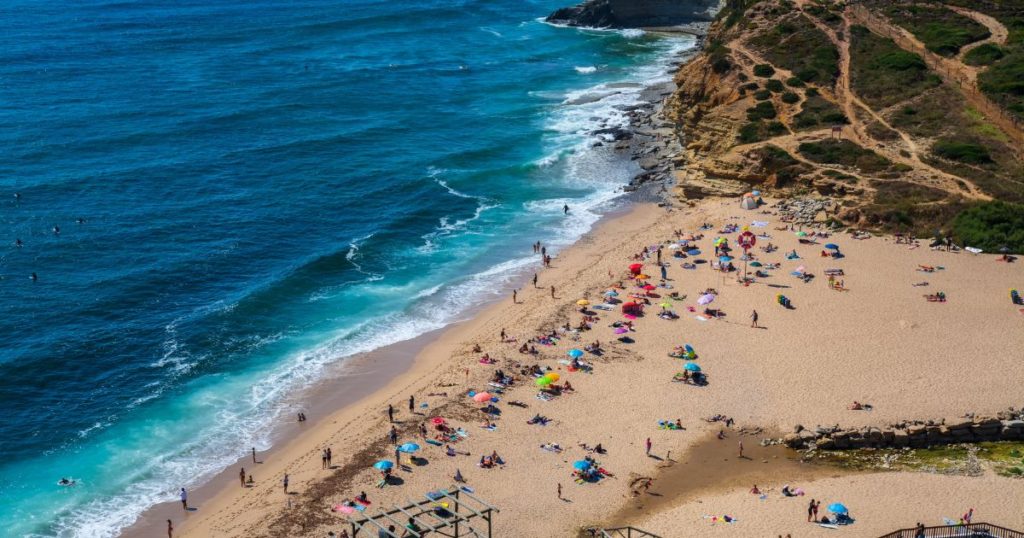
Ericeira
Ericeira is known for its variety and diversity of waves. It is also one of my favorite surf towns I visited in Portugal. There are around 60 different surf breaks in Ericeira with so many options for beginners and experts.
- Praia de Sao Juliao // A beach break making it a perfect beginner spot.
- Praia da Foz do Lizandro // Beginner friendly.
- Praia do Sul // A protected beach right in town.
- Praia do Maduro // A reef break but very beginner friendly.
- Coxos // Intermediate or advanced location. A powerful right with a reef break. If you are an experienced surfer don’t miss out on this break!
I highly recommend visiting Ericeira if you are looking for a town oozing with surf culture and good vibes. If you want to read more about the town itself, here is my ultimate guide to Ericeira.

Peniche
Peniche is another iconic surf location in Portugal. Within a distance of 15km, you can find waves for all levels. Peniche stretches out into the Atlantic, creating a peninsula that has both north and south-facing breaks. From beautiful Baleal to, supertubos – the European Pipeline – Peniche has some of the best surfing spots in Portugal.
Some breaks to check out in Peniche:
- Baleal Beach // The go-to beginner location in Peniche
- Cantinho da Baia // Beginner & intermediate spot depending on conditions
- Supertubos // The wave that put Peniche on the map. This wave is compared to the banzai pipeline for its fast powerful lefts.
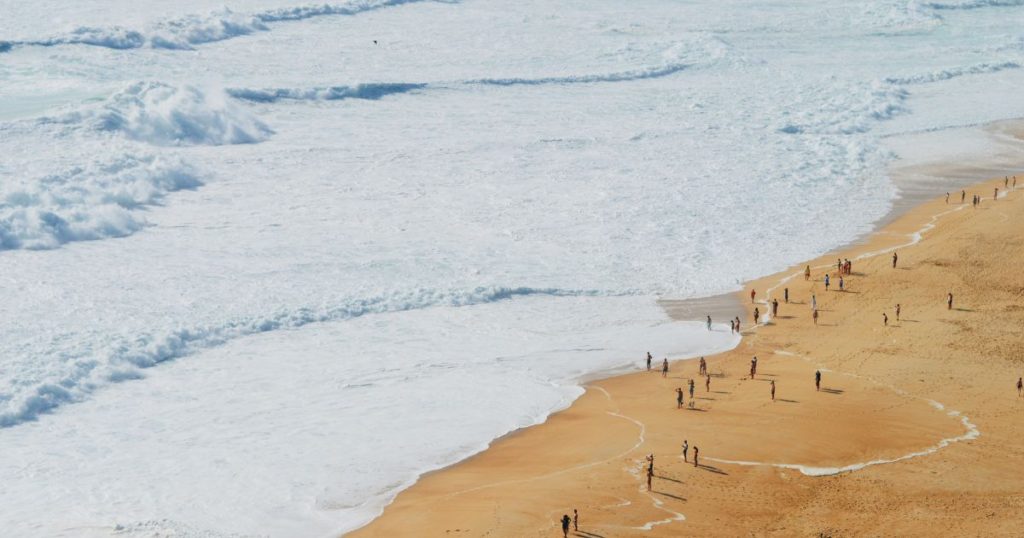
Nazare
Nazare is world renowned for big wave surfing. In the winter the swells can be as big as 80 feet and professional big wave surfers fly from all over the world to surf these monster waves.
From April – September advanced surfers can test their skills on the more moderate breaks. In the winter, the waves should be left to the pros, but it is an amazing experience to go to watch the action. If you find yourself in Portugal in November I highly recommend going to Nazare for a day trip to see the spectacle.
Surf Spots in Nazare
- Praia do Norte // This beach needs no introduction. This is where the iconic giant waves hit the coast of Portugal.
- Praia da Nazare // A beach break, still for advanced surfers but something more approachable.
- Praia do Sul // The south-facing break in Nazare, an experienced surfers’ spot.
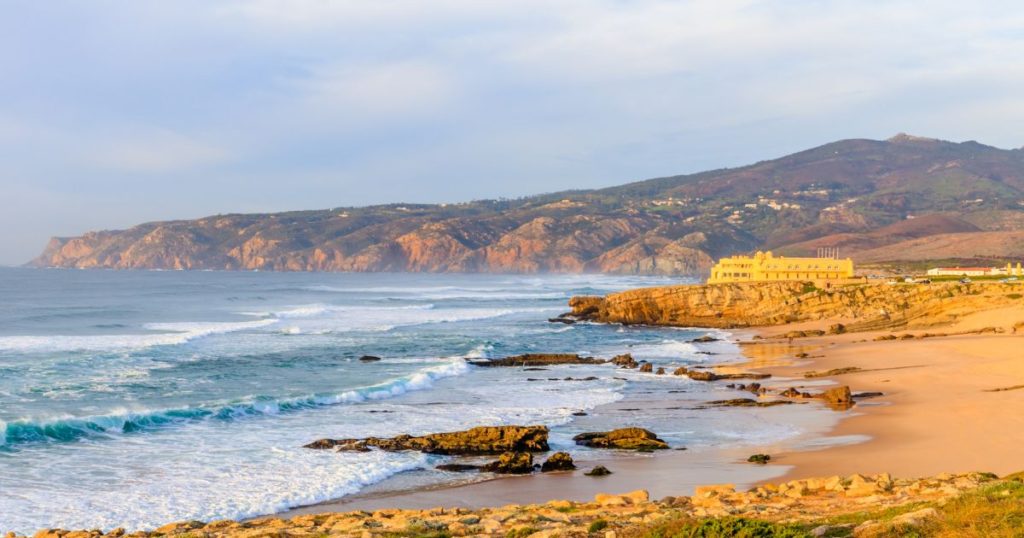
Cascais
Cascais is a great area for beginner surfers and one of the most popular surf destinations near Lisbon. There are several locations that have lessons, rentals, and beach facilities including bathrooms and food.
Some surf breaks near Cascais:
- Praia do Guincho // A popular beginner beach. Because of its exposure to the Atlantic, it can be very windy making it a great destination for kite surfers and windsurfers.
- Sao Pedro do Estoril // A good alternative to Carcavelos (more on that later)
There are also other more advanced locations as you drive north from Cascais. If you are looking for other beaches to explore in this area, check out my post on the 7 Best Sintra Beaches.

Lisbon
Lisbon is a great home base for a surf holiday. There are tons of surf breaks within an hour (or less) drive from Lisbon. You can enjoy city life and take day trips to the numerous beaches surrounding. Some of the areas I suggest near Lisbon for surfing are Costa da Caparica, Carcavelos, and Praia do Guincho.
Ericeira, Cascais, and Peniche are also all easily accessible from Lisbon.
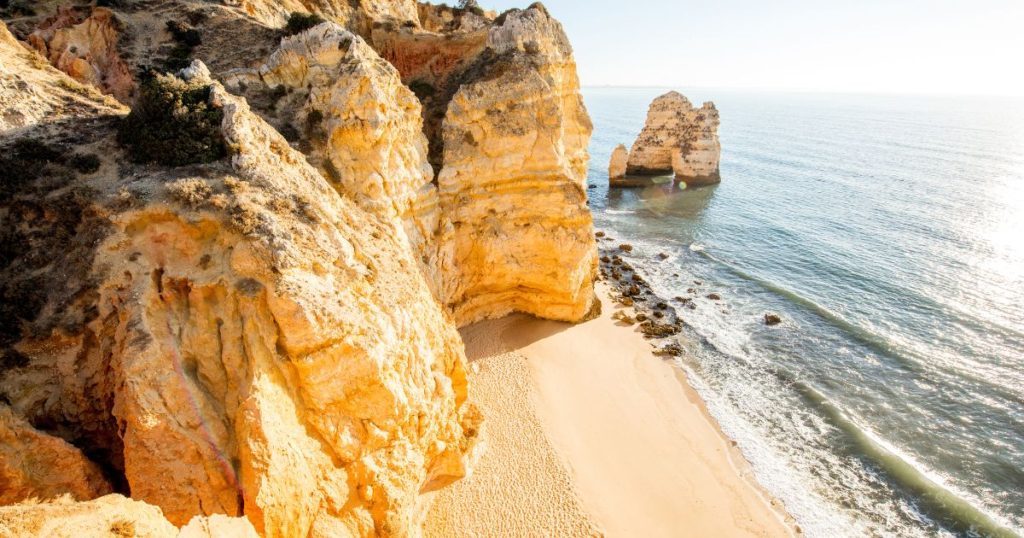
Lagos
Because Lagos is on Portugal’s southern coast, it is protected from the large western Atlantic swells making it a great location for beginner surfers. There are two main locations for surfing in Lagos; Porto de Mos and Meia Praia. Porto de Mos has a flat rock reef break and a smaller sand break. If you visit in the summer and want some bigger waves, it is easy to drive from Lagos to locations on the west coast.
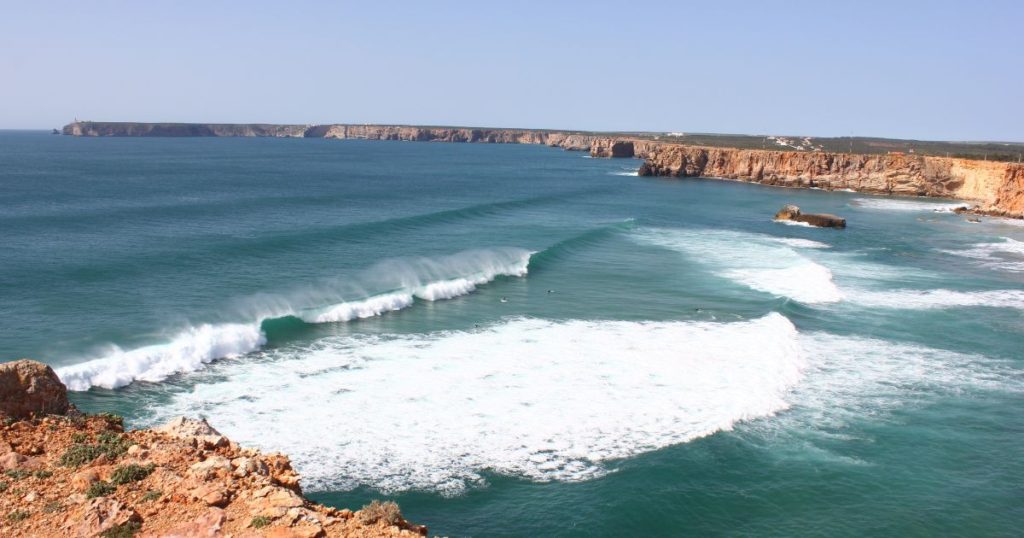
Sagres
Sagres is one of the best locations for surfing in the Algarve. It is the most southwestern point in Europe, known as the end of the world, and it stretches out into the ocean. Because of this, when the waves are too big on the west coast, you can still surf on the south coast. There are many beaches to choose from and almost year-round good weather.
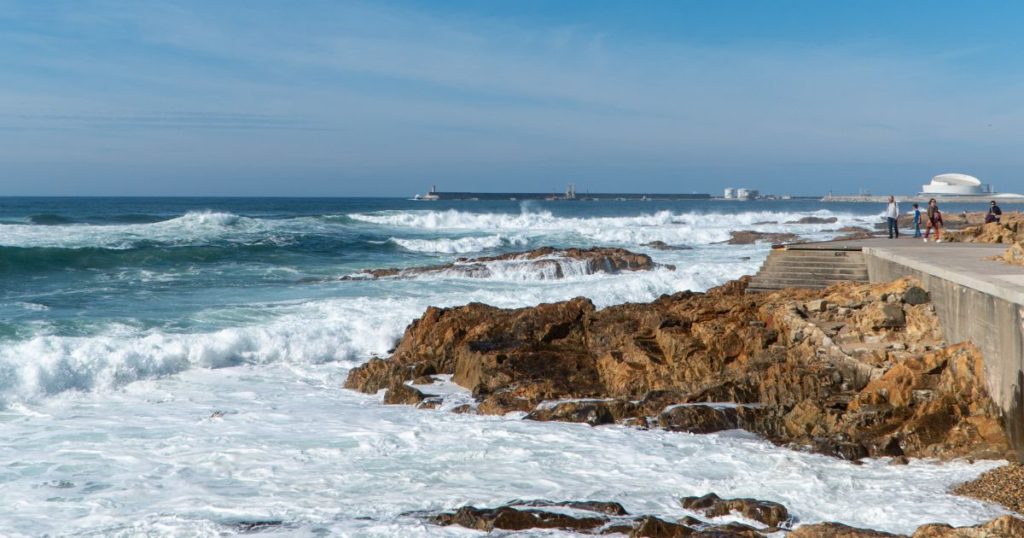
Porto
I couldn’t leave this post without at least one recommendation for surfing in the north of Portugal. Porto is a historical city with a few great surf spots nearby. Matosinhos is one of the best places to surf in Northern Portugal. It has a long coastline and plenty of places for rentals or lessons. Espinho is just outside of Porto, a short train ride away. This is a better option for intermediate or advanced surfers and has a few neighboring beaches nearby.
DO YOU NEED A WETSUIT TO SURF IN PORTUGAL
The short answer is yes, you definitely need a wetsuit to surf in Portugal. The type of wetsuit depends on your location and time of year.
Summer // In the North & West coast you will need a 3/2mm wetsuit and in the South you can sometimes get away with no wetsuit but many people opt for a shortie 2mm.
Winter // In the North & West Coast you will need a 4/3mm or a 5/4mm with booties. In the South, you can use a 3/2mm.
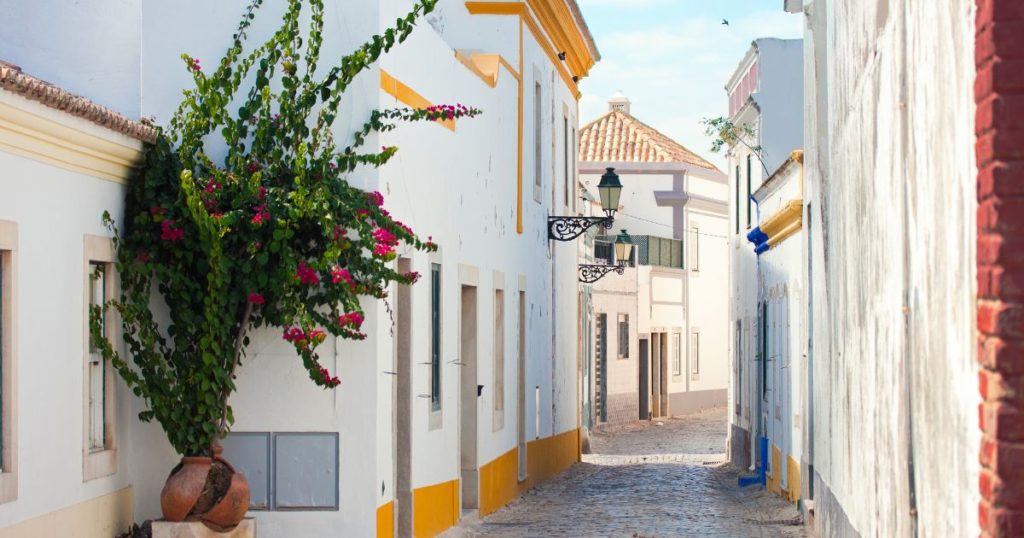
BEST SURF CAMPS IN PORTUGAL
The endless surf in Portugal has the surf retreats to match. Many of the accommodation options in Portugal cater to surfers and emulate their laidback vibe with boho decor, yoga, and healthy food. I was very impressed with the accommodation in Portugal. Here are some of my top pics for each of the places mentioned above.
Sagres
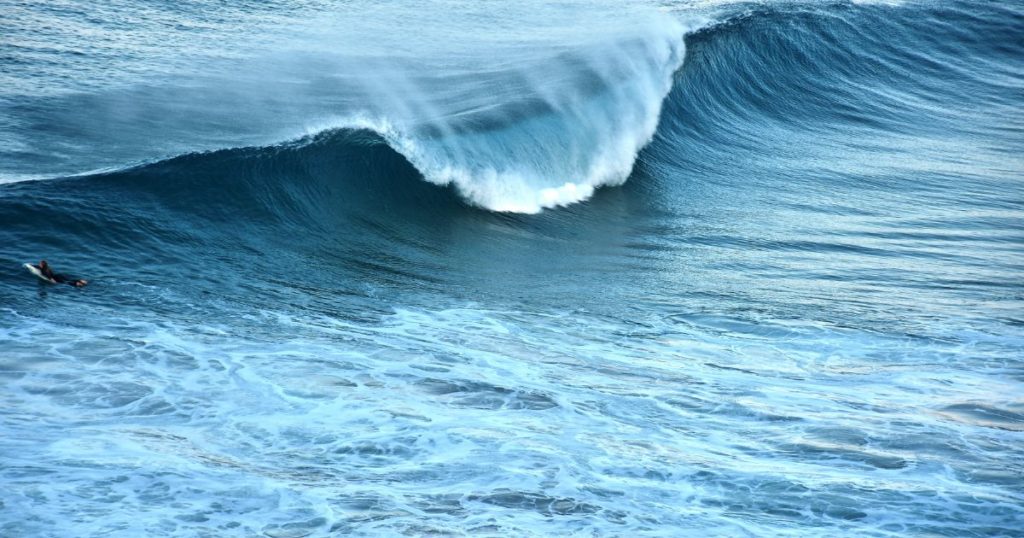
SAFETY TIPS FOR SURFING IN PORTUGAL
Check the Surf Report Before You Go Out
Check the size of the waves.
Make sure to check the surf forecast before you go out surfing. It is important to know the height of the wave and what size of wave you are comfortable surfing in. Don’t go out when conditions are above your skill level. Sometimes this means checking your ego and staying on the shore when waves are too big. This is all a part of the sport.
Check the tides.
It is also important to know when low and high tides are and what tide is best for the beach you are surfing at. Certain breaks are better at different tides and can even be dangerous at the wrong time.
Learning how to interpret a surf report is all a part of surfing and will help you stay safe and within your skill range. The app I used while in Portugal was MagicSeaweed. It will show you the size of the waves and the times of low and high tide and it’s super easy to read as a beginner.
Go With a Buddy
Even if you are traveling alone, it is easy to find a surf buddy in Portugal. Go out with other guests from your surf camp or at least make sure there are other people in the water. I would suggest that beginner/intermediate surfers generally try to avoid surfing alone as a safety precaution.
Be Aware of Beach Flags
Beach flags can indicate whether or not the conditions are safe to surf or not. A red flag means staying out of the water completely. Yello means no swimming but you can paddle. Green means you can swim. The Blue and white checkered flag means that the beach doesn’t have a lifeguard at the moment. The yellow and red striped flag means that the area is being patrolled by lifeguards and indicates the safest place to swim.
Come Prepared With the Correct Gear & Follow Surf Etiquette
Make sure you are wearing the appropriate wetsuit, booties, hood, sunscreen, etc. Always make sure to wear your leash and hold on to your board and be aware of your surroundings. If you are a beginner, take a surf lesson to learn the basics of surf ettiquite so that you don’t put yourself or others in danger.
ALL IN ALL: THE BEST TIME TO SURF IN PORTUGAL
The best time to surf in Portugal depends on your skill level, time of year, and location – but overall, Portugal is one of the most consistent places to find great surf no matter what your skill level. Whether you want to brave the icy waters and barrels of the north coast or chill out on your longboard in the sunny Algarve, Portugal has it all.
Surfing in Portugal was such a great experience for me, it challenged me, pushed me outside my comfort zone, and taught me so much about the sport. Portugal is a bucket-list surf location so if you have the chance to surf in Portugal don’t miss out!